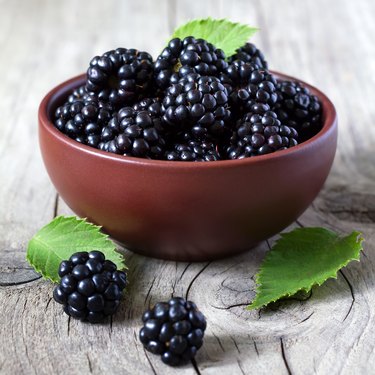
If you crave fresh-picked, sun-warmed blackberries but balk at cultivating blackberry shrubs (Rubus spp.) because they gang up on you in the backyard, remember that growing aggressive plants in containers prevents them from taking over your garden. Just give them a location with at least six hours of sunshine a day and acidic, sandy, well-drained soil, and they'll flourish in U.S. Department of Agriculture plant hardiness zones 3 through 10, depending on species and cultivar.
Container Benefits
Video of the Day
It's easy to find good reasons for planting blackberry shrubs in pots instead of your garden beds. If your backyard has alkaline soil or clay soil that doesn't drain quickly, cultivating berries in containers lets you avoid all the soil amendments required for growing them in the ground. If you live in a house with a small garden or none at all, containers may be your only option. Perhaps the most persuasive reason to think container gardening when it comes to blackberries, though, is their tendency to spread rapidly and clump densely, making an established patch of them difficult to eradicate later.
Video of the Day
Preparing a Container
Select a container for your blackberry shrub that holds at least 5 gallons. It should be at least 18 to 24 inches wide and 12 to 16 inches deep. Fill the pot to within 6 inches of the top with 1 part peat moss to 1 part potting soil. Add several inches of organic, weed-free compost and blend well. Remove half of the soil with the trowel or shovel and set it aside for planting time.
Picking Your Plant
When your container is ready, choose a blackberry cultivar or variety with an erect growth habit rather than one that trails. Erect blackberry plants have thick, stiff canes that can usually support themselves without a trellis. It's also important to pick a cultivar that's guaranteed to be free of viruses and thorns, such as Black Satin (Rubus subgenus Rubus Watson 'Black Satin', USDA zones 5 through 8) or Chester (Rubus fruticosus 'Chester', zones 5 through 8), These varieties are also less vigorous and thus less likely to rapidly outgrow their containers.
Planting Time
You can plant a blackberry bush in a container at any time of year, but early spring is best. To do so, remove the shrub from its nursery container by squeezing on the sides gently. Set the plant on top of the soil in its new pot; then use the trowel or shovel to fill in around the plant with the soil you set aside. The plant should end up at the same depth at which it was planted in its nursery container. Add water slowly until it drips from the drain holes in the bottom of the container. Plant only one shrub per container.
Ongoing Care
Blackberries are thirsty shrubs to begin with, and container plants dry out faster than those in the ground. This makes irrigation important to potted blackberries. Frequently check to see if your shrub needs water by scratching the soil surface. If the top inch of soil is dry, add water slowly until the excess runs out of the holes in the bottom of the container. In hot, dry climates, you may have to check soil moisture and irrigate a few times a week or every day. Covering the soil with a few inches of organic mulch helps hold in the moisture, but keep the mulch several inches away from the canes.
Fertilize your containers conservatively in late spring or early summer by mixing 1 tablespoon of 10-10-10 or similar water-soluble fertilizer or plant food with 1 gallon of water. Pour the mixture evenly over the soil surface in each container. Repeat four to six weeks later. Excessive fertilizer can injure blackberries, so thoroughly water your containers before applying fertilizer to them. Doing so helps prevent damage to the plants.
Starting the second year, prune your container-grown blackberry shrubs early in the growing season in the same way you would if they were planted in the ground. First, sterilize the blades of the pruner by soaking them or wiping the blades in rubbing alcohol and allowing them to air-dry. Trim out any damaged canes or canes that rub against others. Trim back second-year canes to between 40 and 42 inches and lateral branches to about 12 to 18 inches. Prune the shrubs again in winter to remove dead canes that produced fruit the prior summer. Dispose of all clippings.
Cold Protection in Winter
If you live in an area with a cold climate, you'll have to help your containerized blackberries survive the winters. Do this by placing your potted shrubs in a garage or outbuilding during the coldest months. Alternatively, if your region is cool in winter but not cold, heap soil, compost, straw or other insulating material around the pot to help hold in heat. If possible, sink the container into the ground.
- The Old Farmer's Almanac: Blackberries
- Monrovia: Black Satin Blackberry
- University of Georgia: Growing Erect Blackberries
- Arbor Day Foundation: Blackberry
- BrazelBerries Growing Guide: 'Raspberry Shortcake'
- EasyGrow Custom Blended Fertilizer Label
- Maximum Yield: Bring on the Berries: A Beginner’s Guide to Growing Berries in Containers